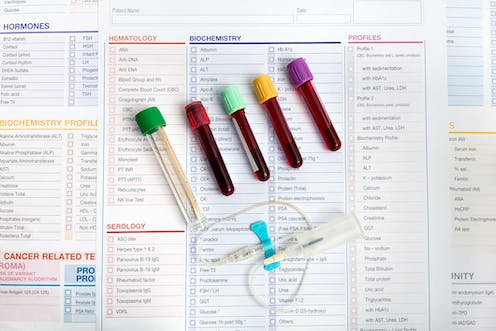
From CBC to CMP and beyond, blood test panels provide essential information to health practitioners. angelp/iStock via Getty Images Plus
Your blood serves numerous roles to maintain your health. To carry out these functions, blood contains a multitude of components, including red blood cells that transport oxygen, nutrients and hormones; white blood cells that remove waste products and support the immune system; plasma that regulates temperature; and platelets that help with clotting.
Within the blood are also numerous molecules formed as byproducts of normal biochemical functions. When these molecules indicate how your cells are responding to disease, injury or stress, scientists often refer to them as biological markers, or biomarkers. Thus, biomarkers in a blood sample can represent a snapshot of the current biochemical state of your body, and analyzing them can provide information about various aspects of your health.
As a toxicologist, I study the effects of drugs and environmental contaminants on human health. As part of my work, I rely on various health-related biomarkers, many of which are measured using conventional blood tests.
Understanding what common blood tests are intended to measure can help you better interpret the results. If you have results from a recent blood test handy, please follow along.
Blood samples go through several processing steps after they’re drawn.
Normal blood test ranges
Depending on the lab that analyzed your sample, the results from your blood test may be broken down into individual tests or collections of related tests called panels. Results from these panels can allow a health care professional to recommend preventive care, detect potential diseases and monitor ongoing health conditions.
For each of the tests listed in your report, there will typically be a number corresponding to your test result and a reference range or interval. This range is essentially the upper and lower limits within which most healthy people’s test results are expected to fall.
Sometimes called a normal range, a reference interval is based on statistical analyses of tests from a large number of patients in a reference population. Normal levels of some biomarkers are expected to vary across a group of people, depending on their age, sex, ethnicity and other attributes.
So, separate reference populations are often created from people with a particular attribute. For example, a reference population could comprise all women or all children. A patient’s test value can then be appropriately compared with results from the reference population that fits them best.
Reference intervals vary from lab to lab because each may use different testing methods or reference populations. This means you might not be able to compare your results with reference intervals from other labs. To determine how your test results compare with the normal range, you need to check the reference interval listed on your lab report.
If you have results for a given test from different labs, your clinician will likely focus on test trends relative to their reference intervals and not the numerical results themselves.
Interpreting your blood test results
There are numerous blood panels intended to test specific aspects of your health. These include panels that look at the cellular components of your blood, biomarkers of kidney and liver function, and many more.
Rather than describe each panel, let’s look at a hypothetical case study that requires using several panels to diagnose a disease.
In this situation, a patient visits their health care provider for fatigue that has lasted several months. Numerous factors and disorders can result in prolonged or chronic fatigue.
Based on a physical examination, other symptoms and medical history, the health practitioner suspects that the patient could be suffering from any of the following: anemia, an underactive thyroid or diabetes.
Blood tests provide clinicians with more information to guide diagnoses and treatment decisions.
FluxFactory/E+ via Getty Images
Blood tests would help further narrow down the cause of fatigue.
Anemia is a condition involving reduced blood capacity to transport oxygen. This results from either lower than normal levels of red blood cells or a decrease in the quantity or quality of hemoglobin, the protein that allows these cells to transport oxygen.
A complete blood count panel measures various components of the blood to provide a comprehensive overview of the cells that make it up. Low values of red blood cell count, or RBC, hemoglobin, or Hb, and hematocrit, or HCT, would indicate that the patient is suffering from anemia.
Hypothyroidism is a disorder in which the thyroid gland does not produce enough thyroid hormones. These include thyroid-stimulating hormone, or TSH, which stimulates the thyroid gland to release two other hormones: triiodothyronine, or T3, and thyroxine, or T4. The thyroid function panel measures the levels of these hormones to assess thyroid-related health.
Diabetes is a disease that occurs when blood sugar levels are too high. Excessive glucose molecules in the bloodstream can bind to hemoglobin and form what’s called glycated hemoglobin, or HbA1c. A hemoglobin A1c test measures the percentage of HbA1c present relative to the total amount of hemoglobin. This provides a history of glucose levels in the bloodstream over a period of about three months prior to the test.
Providing additional information is the basic metabolic panel, or BMP, which measures the amount various substances in your blood. These include:
Glucose, a type of sugar that provides energy for your body and brain. Relevant to diabetes, the BMP measures the blood glucose levels at the time of the test.
Calcium, a mineral essential for proper functioning of your nerves, muscles and heart.
Creatinine, a byproduct of muscle activity.
Blood urea nitrogen, or BUN, the amount of the waste product urea your kidneys help remove from your blood. These indicate the status of a person’s metabolism, kidney health and electrolyte balance.
With results from each of these panels, the health professional would assess the patient’s values relative to their reference intervals and determine which condition they most likely have.
Understanding the purpose of blood tests and how to interpret them can help patients partner with their health care providers and become more informed about their health.
Brad Reisfeld does not work for, consult, own shares in or receive funding from any company or organization that would benefit from this article, and has disclosed no relevant affiliations beyond their academic appointment.
Advertisement

Advertisement
Contact Us
If you would like to place dofollow backlinks in our website or paid content reach out to info@qhubonews.com











